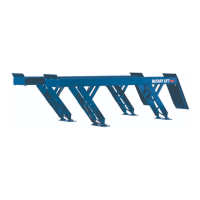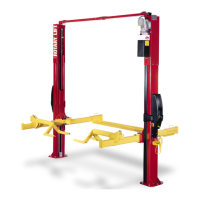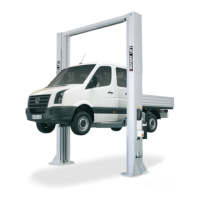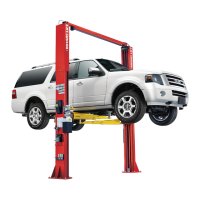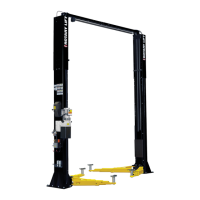12
9. Commissioning
9.1 Check Operation
Operate lift and assure that push button raises
lift when pushed and stops lift when released.
Check disconnect switches for cutting power to
pushbuttons. Also check that limit switch stops lift
from lowering when actuated.
Lubricate the surface of slide between the top
platform and base frame before commissioning. It
can be applied by brushing. This can significantly
increase the service life of the lift.
9.2 Test the hydraulic system
1.Set the main switch to ON.
2.Move the unloaded lift to full rise and the
bottom position several times using the Up and
Down buttons. This will completely remove any air
pockets in the hydraulic system.
3.Press up button to raise lift to full rise and
kee
p motor running for 5 seconds. Stop and check
all hoses connections. Tighten or reseal if required.
4.Carry out a visual inspection of the hydraulic
and pneumatic system. In doing so, check all lines,
especially the couplings. No leaks must be found.
5.Lower the lift completely and check the
hydraulic oil level. This must also correspond to the
maximum level.
6.Finally check that the hydraulic components
are fitted securely.
10. Disposal
10.1 Environmental procedures for
disposal
Prevent environmental hazards.
Avoid contact with or inhalation of toxic sub-
stances such as hydraulic fluid
Oils and lubricants are water pollutants under
the terms of the Water Management Act WGH.
Always dispose of
these in an environmentally
friendly manner in compliance with the
regulations which apply in your country.
Hydraulic oil-based on mineral oil is a water
pollutant and is combustible. Refer to the
relevant safety data sheet for disposal.
Provide suitable oil drain pans and oil
absorbents to drain the oil.
Ensure that no hydraulic oil, lubricants, or
cleaning materials contaminate the soil or
wash away into the drainage system.
10.2 Packaging
Do not dispose of with domestic waste! The
packaging contains some recyclable material which
must not disposed of with domestic waste.
Dispose of packaging materials in compliance
with local regulations.
10.3 Oils, grease, and other
chemical substances
When working with oil, grease and other
chemical substances, comply with the
environmental regulations which apply to the
relevant product.
Dispose of oil, grease and other chemical
substances in compliance with the environmental
regulations which apply in your country.
10.4 Metals / Electronic waste
This must always be properly disposed of by a
certified company.
Dispose of used electrical and electronoc
devices ,including cables,accessories
and batteries,separately from household
waste.
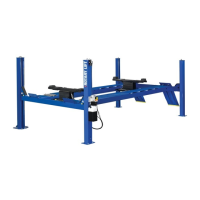
